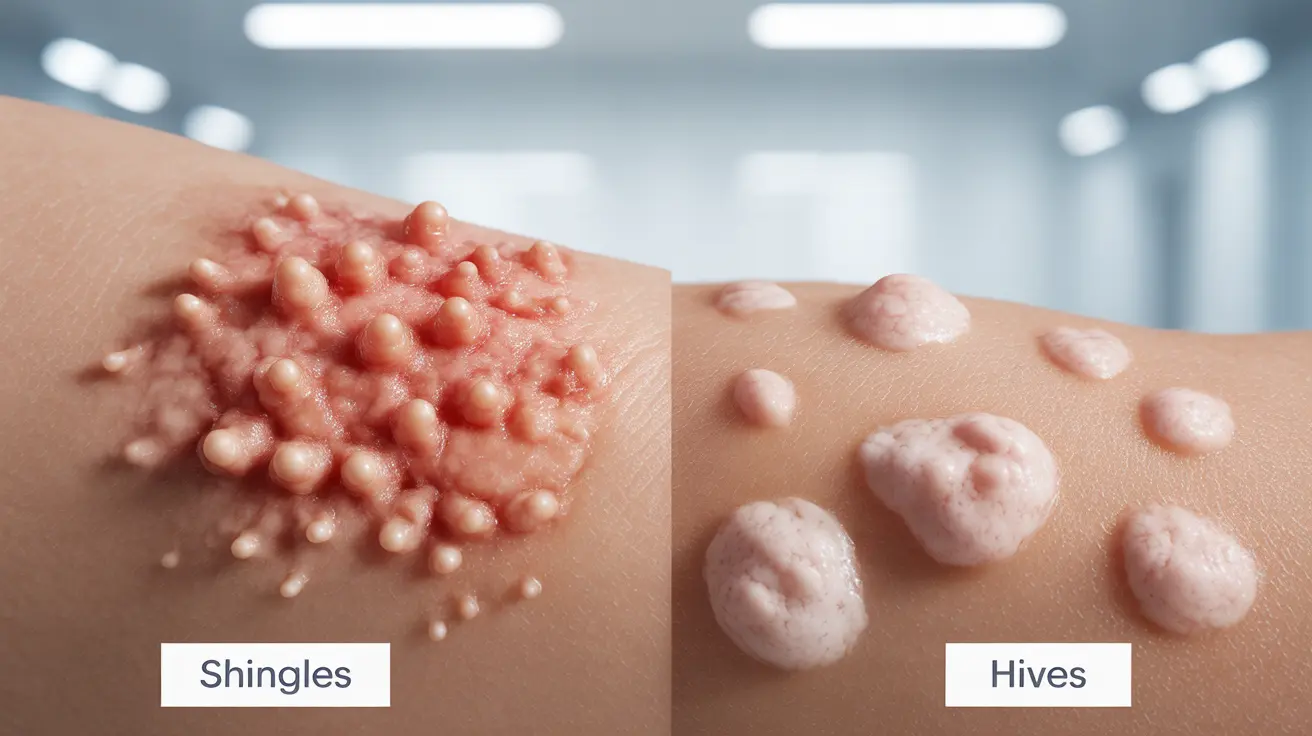When unusual skin symptoms appear, distinguishing between shingles and hives can be challenging for many people. While both conditions affect the skin and can cause discomfort, they have distinct causes, symptoms, and treatment approaches. Understanding these differences is crucial for getting the right diagnosis and appropriate care.
In this comprehensive guide, we'll explore the key characteristics of both conditions, helping you recognize their unique features and understand the specific care each requires.
Understanding Shingles: Causes and Characteristics
Shingles, also known as herpes zoster, is caused by the reactivation of the varicella-zoster virus, the same virus responsible for chickenpox. This condition typically develops in people who have previously had chickenpox, often years or decades later.
Key Features of Shingles
Shingles presents with several distinctive characteristics:
- Painful, blistering rash that follows nerve patterns
- Usually appears on one side of the body
- Often preceded by burning or tingling sensations
- Typically lasts 2-4 weeks
- Blisters that eventually crust over
Understanding Hives: Causes and Characteristics
Hives, medically known as urticaria, are allergic reactions that occur when the body releases histamine in response to various triggers. Unlike shingles, hives are not caused by a virus but rather by an immune system response.
Key Features of Hives
Hives have their own distinct characteristics:
- Raised, itchy welts that can appear anywhere on the body
- Can change size and location within hours
- May be triggered by allergens, stress, or other factors
- Usually resolve within 24 hours, though new ones may form
- Can be acute (short-term) or chronic (lasting more than 6 weeks)
Diagnostic Approaches
Healthcare providers use different methods to diagnose these conditions. Shingles is often diagnosed through visual examination and patient history, particularly noting previous chickenpox infection. For hives, doctors typically review recent exposures to potential triggers and may recommend allergy testing in some cases.
Treatment Strategies
Treating Shingles
Shingles treatment typically involves:
- Antiviral medications (most effective when started early)
- Pain management medications
- Topical treatments for skin discomfort
- Rest and stress reduction
- Protection of the affected area
Treating Hives
Hive treatment usually focuses on:
- Antihistamines to reduce symptoms
- Identifying and avoiding triggers
- Cool compresses for comfort
- In severe cases, oral steroids
- Lifestyle modifications to prevent recurrence
Prevention and Long-term Management
Prevention strategies differ significantly between these conditions. Shingles can be prevented with vaccination, particularly recommended for adults over 50. Hives prevention focuses on avoiding known triggers and maintaining good overall health.
Frequently Asked Questions
What are the key differences between shingles and hives in terms of symptoms and appearance?
Shingles typically appears as a painful, blistering rash confined to one side of the body following nerve patterns. Hives present as itchy, raised welts that can appear anywhere on the body and often change location. Shingles causes burning pain, while hives primarily cause itching.
How do doctors diagnose shingles versus hives, and what are the typical tests involved?
Doctors typically diagnose shingles through visual examination and patient history, particularly focusing on previous chickenpox infection. Hives diagnosis usually involves reviewing recent exposure history and potential triggers. In some cases, doctors may perform additional tests to rule out other conditions.
What are the most effective treatments for shingles and hives, and how do they differ?
Shingles treatment focuses on antiviral medications and pain management, while hives treatment primarily involves antihistamines and trigger avoidance. Shingles requires prescription medication, whereas hives often respond to over-the-counter treatments.
Can certain foods or environmental factors trigger both shingles and hives, or are the triggers different?
The triggers are different for each condition. Shingles is triggered by virus reactivation, often due to weakened immunity, stress, or aging. Hives can be triggered by various factors including foods, medications, environmental allergens, stress, and physical factors like pressure or temperature changes.
How can I prevent getting shingles or hives, and are there any vaccines available for either condition?
There is a vaccine available for shingles (Shingrix) recommended for adults over 50. There is no vaccine for hives, but prevention focuses on identifying and avoiding triggers, maintaining good health, and managing stress levels.




